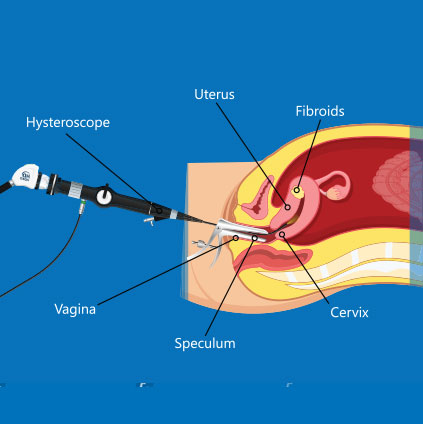
Hysteroscopy
Hysteroscopy
Hysteroscopy is a procedure in which a thin telescope is inserted into the vagina to examine the cervix and inside of the uterus. Hysteroscopy can be either diagnostic or operative.
Hysteroscopy is a gold standard for visualisation of uterine cavity and treatment of any pathology inside the uterus.
Indications
- Patients with history of past pelvic infection or tuberculosis
- Abnormal findings on Ultrasound or Hysterosalpingography (HSG)
- Thin endometrium during fertility treatment
- Recurrent implantation failure
- Recurrent miscarriage
- Abnormal uterine bleeding

Diagnostic Hysteroscopy
Diagnostic Hysteroscopy is used to diagnose the problems of the uterus.
Operative Hysteroscopy
Operative Hysteroscopy is used to correct any abnormalities detected during a diagnostic hysteroscopy. If an abnormal condition is detected during the diagnostic hysteroscopy, an operative hysteroscopy can be performed at the same time.
The following problems can be identified and needs correction
- Polyps and fibroids – these are small growths found inside the uterus and interfere with implantation of embryo.
- PoorAdhesions or Asherman’s syndrome - Uterine adhesions are bands of scar tissue that can form in the uterus due past history of infections, particularly tuberculosis or following multiple D+C procedures. Hysteroscopy can help to locate and clear these adhesions.
- Partial or complete septum - septum is birth defect in the uterus by which a partition is present inside the uterus, which interferes with implantation of embryo and increases risk of miscarriage. Hysteroscopy can help determine presence of septum and also correct it.
- Tubal block - hysteroscopic tubal cannulation can be done to try to open the tubal blocks.
Hysteroscopy is usually scheduled in the first week after the menstruation. At this time, the uterine lining is thin and there is no bleeding, so the views inside the uterus are best.
Hysteroscopy can also performed to determine the cause of unexplained bleeding, heavy periods or spotting in postmenopausal women.
At our centre we use world-class equipment for hysteroscopy. We run a training program for gynaecologists in the art of hysteroscopy and have international and national guest faculty as well.